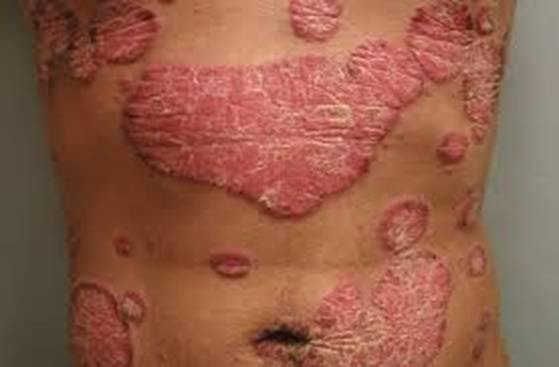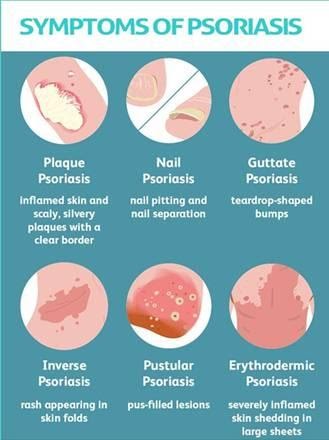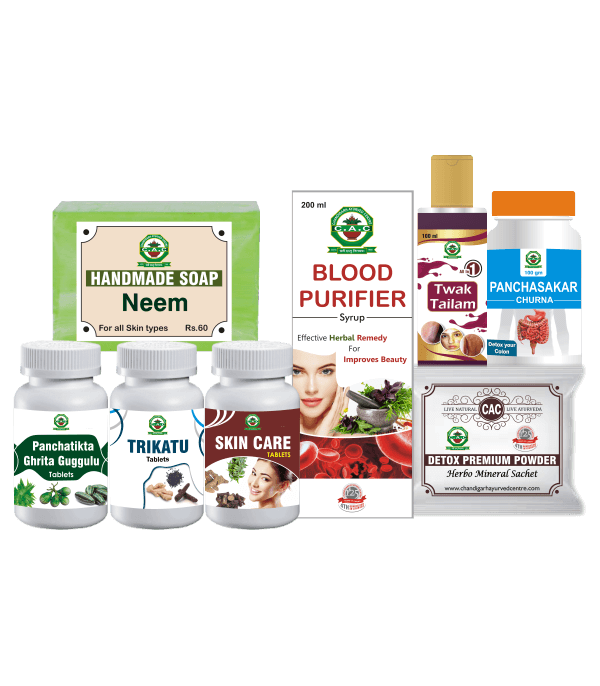
PSORIASIS
- April 21, 2021
- Posted by Dr. Vaidya Karanvir Singh
- 0 Comment(s)
Psoriasis is a disorder of the skin, it’s a multifactorial, complex, inflammatory disorder that involves hyperproliferation of the keratinocytes. This can cause red, itchy scaly patches generally on the knees, elbows, trunk, and scalp areas. In this disease, there is an increase in the epidermal cell turnover rate.
Table of Contents
There are some factors which play a role:-
– Environmental
– Genetic
– Immunologic
Psoriasis most commonly occurs on the region of skin at the areas of elbows, knees, scalp, lumbosacral areas, intergluteal clefts, and glans penis. Joints may also be affected in some patients.
SIGN AND SYMPTOMS:-
- Red patches of skin covered with thick, silvery scales.
- Small scaling spots (commonly seen in children)
- Dry, cracked skin that may bleed or itch.
- Itching, burning or soreness.
- Painful skin can cause the bleeding where the involved skin is scratched
- Thickened, pitted or ridged nails.
- Swollen and stiff joints.
- Recurrent streptococcal infection in the throat.
- Viral infections
- Immunization
- Use of antimalarial drugs
- Trauma can also cause psoriasis
- Blepharitis or Conjunctivitis
- Scaly plaques on the scalp can occur
- Psoriasis in the fingernails and toenails, with discoloration and pitting conditions; the nails may become crumble and detach from the nail bed.
- This disorder can also cause Psoriatic Arthritis, which can cause achy and swelling in joints
- In severe cases, the plaque can occur and spread into another skin, it may covering large areas.
- Use of the long term steroids cause rash with the presentation of joint pain.
- Dystrophic nails, may resemble onychomycosis
TYPES OF PSORIASIS:-
Chronic Stationary Psoriasis/Psoriasis Vulgaris:-
- This is the most common type of psoriasis which involves the retro auricular regions, lumbosacral areas, umbilicus, genitals, exterior surfaces, and skin areas.
Plaque Psoriasis:-
- It commonly affects the external surface of the scalp, trunk, knees, and elbows
Guttate Psoriasis:-
- It affects the areas of the trunk; it frequently affects within 2 to 3 weeks after the infections of the upper respiratory tract. in this condition, there is severe itching
Inverse Psoriasis:-
- This type of psoriasis involves the areas under the breast, in the skin folds, flexural surface, armpit, groin area; This may be diagnosed as a fungal infections
Pustular Psoriasis:-
- It commonly affects the areas on the palms and soles, and may present over the body
Erythrodermic Psoriasis:-
- It may affect the entire body skin surface areas, it can cause red skin, and a diffuse, peeling scale, and fine skin
Scalp Psoriasis:-
- It involves the scalp areas, and affects 50% of patients
Nail Psoriasis:-
- It is more prone to developing, onychomycosis
Arthritis Psoriasis:-
- It usually affects the hands, feet, and sometimes the large joints
Oral Psoriasis:-
- This type of psoriasis present as severe cheilosis, thid may involves the surrounding skin, it crossing the vermillion border
Eruptive Psoriasis:-
- This type of psoriasis affects on the upper trunk and upper extremities; this mostly seen in younger patients
Napkin Psoriasis:-
- It mostly involves the children’s diaper region
CAUSES OF PSORIASIS:-
∙ Skin cells are replaced in every 10-30 days, but in the Psoriasis Disorder, new cells of the skin form too quickly. So the old cells replaced by new cells, so this creates a Silver scale. This is mainly due to the weak Immune System, which causes the inflammation of the skin.
∙ Generational Cause:-
In this case Psoriasis run in families, It may transfer from Grandfather to His Grandson
∙ Antimalarial Drugs like Chloroquine and Hydroxychloroquine
∙ Medications of Blood Pressure like Beta-Blockers
∙ Surgery
∙ Scarp or cuts
∙ It also causes by Emotional Stress
∙ Strep Infections
DIAGNOSIS:-
The Diagnosis of the Psoriasis Disorder Clinical, Especially it can be Diagnosed if there is the presence of Plaques on the areas described below:-
∙ Upper Trunk
∙ Upper extremities
∙ Nails
∙ Belly Buttons
∙ Scalp
∙ Ears
∙ Elbows
∙ Knees
EXAMINATION OF THE PATIENTS WITH PSORIASIS DISORDER INCLUDES THE FOLLOWING:-
∙ Dermatologic Examination:-
In this type the skin areas are involved with Psoriasis, commonly scaling Erythematous Macules, Papules, Plaques are present
∙ Ocular Examination:-
Ectropion and Trichiasis
Conjunctivitis and conjunctival hyperemia
corneal dryness
punctate keratitis and corneal melt
blepharitis
∙ Musculoskeletal Examination:-
It can be Diagnosed by the Tenderness of joints
Stiffness of the joints
Pain in the joints
throbbing joints
swelling of the joints
In this condition the fingers, toes, wrist, hands, knees, and ankles joints are more affected.
In this type of Psoriasis may progress from mild to severe
LAB INVESTIGATIONS:-
Laboratory Studies and Findings for Psoriasis Patients are following:-
∙ CBC Count (Complete Blood Count)
∙ BUN (Blood Urea Nitrogen)
∙ Creatinine Levels
∙ LFT (Liver Function Test)
∙ Hepatitis Panel Test
∙ TB Screening Test
∙ HIV Testing
∙ Pregnancy Test
∙ Rheumatoid Factor Level:-
This test is usually Negative
∙ Erythrocyte Sedimentation Rate:-
In Pustular and Erythrodermic Psoriasis condition, There is an elevation in the White Blood Corpuscles Count, But in some patients this test usually normal
∙ Uric Acid Test Level:-
In Psoriasis the Uric Acid may be Elevated, mostly in Pustular Psoriasis
∙ Pustular Fluid Examination:-
In this condition the examination of the Pustular fluid; Sterile Bacterial Culture with The Neutrophilic Infiltrate
∙ Fungal Examination:-
This test is usually done in the conditions of Hands, Feet, and Nails
∙ Conjunctival Impression Cytology:-
This Examination is usually done in the conditions of Increased incidence of squamous metaplasia, snakelike chromatin, and neutrophil clumping
The Other Studies Shows That:-
∙ Radiographs of the Affected Joints:-
This test is helpful in differentiating the Arthritis types
∙ Joint Radiographs:-
This test also helpful to Diagnose the Psoriasis-Arthritis
∙ Bone Scan:-
This test shows joint involvement early
AYURVEDIC REVIEWS:-
According to the AYURVEDA PRACTITIONERS There are Three Types of Doshas in our body, which are responsible to control the body functions. These are Following:-
∙ Vata Doshas:- This Doshas controls the whole body functions.
∙ Pitta Doshas:- This Doshas controls our metabolic functions.
∙ Kapha Doshas:- This Doshas controls the growth in the cells of the body.
According to the AYURVEDA Psoriasis can be caused due to the Imbalance of “Doshas” mainly Two Doshas. Ayurvedic Medical Practitioners detect that there is the involvement of “Vata Dosh” and “Kapha Dosh” inPsoriasis. Mainly The “Vata Dosha” is responsible for the Dryness of the skin tissue and it can also cause the scaling of the skin. Ayurvedic Doctors also believe that if your Doshas are imbalanced your body becomes sick and you can also suffer from stress-like conditions.
TREATMENT:-
The Ayurvedic Treatment is mainly based on the following:-
∙ A healthy Lifestyle
∙ Herbal remedies
∙ Healthy Diet
∙ Detoxification
∙ Medication
∙ Yoga like Exercises
∙ Panchakarma Therapy
PANCHAKARMA THERAPY TREATMENT:-
This is the main Ayurvedic Treatment mainly used to treat the Psoriasis.
This Treatment involves Herbal based remedies and a healthy vegetarian diet. This Panchakarma Treatment Purify and Detoxify the body.
These Panchakarma Treatments Include:
- First:- Consuming medicated, Ghee, or Clarified butter.
- Second:- Purging and vomiting.
- Third:- Dripping medicated buttermilk on the head of the patient.
- Fourth:- Applications of The Medicated Paste and Mud over the whole body.
- Fifth:- Medicated Enemas.
CHANDIGARH AYURVED AND PANCHAKARMA CENTER has pioneer in the field of Ayurveda. CAC cures Successfully both Acute and Chronic Disorders.
PSORIASIS CARE KIT

Dr. Vaidya Karanvir Singh is the younger Vaidya in Chandigarh Ayurved & Panchakarma Centre. He is the fourth generation in his family who is practicing as a general consultant in Ayurved & Panchakarma treatment at Chandigarh. In his practice, he had treated more than 1 Lakh Plus patients worldwide.



